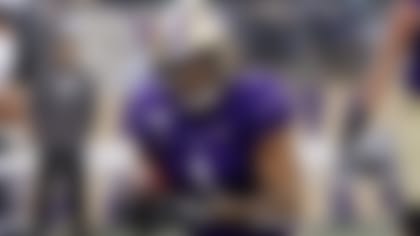The week of the 2020 NFL Draft is officially here! Around the NFL, prospect evaluations are complete and draft boards are set. And after a month-plus of wheeling and dealing in free agency, each team's needs and position priorities can be more easily weighed against the draft order. Of course, it won't take long on draft night for a few trades to blow up everyone's best-laid mock drafts.
Yes, trades are a major component of the madness that is draft weekend. And when teams are conjuring up deals, many reference a chart created back in the 1990s by Jimmy Johnson that quantifies the value of each draft slot. Now, obviously, there are market dynamics that influence pick trades (like actually finding a trade partner and agreeing on terms), but the aforementioned chart provides great context when it comes to understanding more about how a trade is initially valued. Some things, like the exact value of a pick in a future year, can never be fully taken into account because the draft order changes from season to season.
Remember, there are a number of different draft philosophies at play during the event: Some teams believe in amassing a lot of selections, others like to package their picks to choose a specific player. Some teams have a very short list of prospects they're targeting, while others have hundreds of prospects ordered on their board. This article isn't an optimal team draft strategy -- this is a market analysis using the current draft order and equity for each team. For example, the Dolphins have three first-round picks while the Vikings, Raiders, Jaguars and Niners each have two. And then there are the Bears, Texans, Colts, Steelers and Bills who don't pick until the second round.
The work below blends my draft-prospect and team-needs models to provide competitive analysis of each pick. This piece builds off how I approached my mock draft in that its goal is to optimize for wins this season. In areas where surplus value exists, a future draft pick is mentioned. The idea here is to approximate how I would approach this problem for a team that tasked me with analyzing what could happen at each slot using a lot of contextual data.
With all of that in mind, I've put together four potential efficient trades involving high-value selections. These deals would provide the most value for both teams. This means trades that net both teams a higher projected win total, while taking into account who other teams are likely to draft.
NOTE: No trades with players and picks packaged together were included in this analysis.
1) Dolphins secure the QB position
Miami Dolphins receive:
-- 2020 first-round pick (No. 3 overall)
Detroit Lions receive:
-- 2020 first-round pick (No. 5)
-- 2020 second-round pick (No. 39)
Why it works for the Dolphins: Obviously, this deal assumes Cincinnati takes Joe Burrow first overall and Washington selects Chase Young (or a non-QB) right after. If that scenario plays out, Miami should get on the phone with Detroit ASAP. The Dolphins own 14 total picks in the 2020 draft, including three in Round 1 (Nos. 5, 18 and 26) and two in Round 2 (Nos. 39 and 56). For the price of one second-round selection, Miami is free to pick their presumptive quarterback of the future. While giving up the 39th overall pick to move up just two slots might seem pricey, the Fins still have plenty of draft capital to help bolster the rest of their roster. With the Chargers at No. 6 overall and the Raiders (Nos. 12 and 19) and even Jaguars (Nos. 9 and 20) also in possession of enough draft ammo to trade up for a QB, the Dolphins might have to beat them all to the punch.
The Chargers and/or Raiders would have to either cut their own deal with Detroit or work something out with Washington if either wanted a guaranteed shot at their QB of choice. While the Chargers could swap first-rounders with Detroit and offer up the No. 37 overall pick, they'd be left without a second-round selection, which ends up hurting them overall in 2020. The Raiders currently still have Derek Carr as their QB1, so surrendering one of their two first-round picks or a future first-rounder to move up for a quarterback wouldn't net them more wins this season.
Why it works for Detroit: My model shows that the optimal pick for the Lions at No. 3 is cornerback Jeff Okudah. Guess who it is at fifth overall? Yep, also Okudah, and the chances that he's still available occurs in more than 98 percent of my draft simulations. If the Lions wanted to even continue to trade down they could, or they could take the additional second-round pick and package it with the 35th overall selection to trade back into the end of the first round to help address other needs.
2) Vikings trade up for Stefon Diggs' replacement
Minnesota Vikings receive:
-- 2020 first-round pick (No. 13 overall)
San Francisco 49ers receive:
-- 2020 first-round pick (No. 22)
-- 2020 second-round pick (No. 58)
-- 2020 fourth-round pick (No. 132)
Why it works for the Vikings: With two picks in the first round (Nos. 22 and 25), Minnesota can target one of the elite pass catchers in this gifted class. In 65 percent of my simulations, at least one of the top four consensus WRs is still available at No. 13 overall, which is two spots before the receiver-needy Broncos are on the clock.
Why it works for the 49ers: Although San Francisco has two first-round selections, the team doesn't pick again until the fifth round (Nos. 156 and 176). If I worked for the franchise, I'd be spending extra time creating the right valuations on as many receivers and corners as I could to maximize the total draft haul at those positions. You might be wondering why the Niners would trade out at 13, when they also need to add an elite receiver. And that exact point is what gives them tremendous leverage to demand a high value for the slot. Teams know that if they don't come with a strong offer, the Niners could easily stay put and draft a receiver with that pick.
3) Jaguars move up to fortify D-line
Jacksonville Jaguars receive:
-- 2020 first-round pick (No. 14 overall)
Tampa Bay Buccaneers receive:
-- 2020 first-round pick (No. 20)
-- 2020 third-round pick (No. 73)
Why it works for the Jaguars: The Jags hold 12 total picks in the 2020 draft, including three in the first two rounds (Nos. 9, 20 and 42), and have a major need within the interior of their defensive line. Should Auburn defensive tackle Derrick Brown slide (he's available at 14th overall in 57 percent of my draft models), the Jags should be all over moving up to grab him -- especially for a mere third-round pick. Several mocks have the Falcons targeting a defensive lineman, either by trading up (though my model suggests they should actually be trying to trade down to acquire more picks, especially another one in Round 2) or at 16th overall. Leapfrogging the Dolphins and Raiders before they're able to use the second of their multiple 1s would be beneficial for the Jags, too. The minimal value surrendered compared with the return for the spot creates the best win-share uptick for Jacksonville. This approach also allows the Jags to stay extremely nimble (they give up so little), as they need depth at corner as well.
Why it works for the Buccaneers: At 14th overall, Tampa Bay is in prime receiver-picking territory. Fortunately for them, that's obviously not an area of concern at the moment. What is a more pressing need, though, is offensive tackle. My model gives very good odds (51 percent of simulations) to at least one of the four best tackles in the draft class still being available at pick No. 20. So the opportunity cost to get their win-optimized-targeted player even after dropping down six spots is almost unchanged. Therefore they can pick up a bookend tackle in Round 1, still acquire a high value running back in Round 2 (they hold pick No. 45) and add an additional third-rounder to their draft arsenal. That outcome would surely bring a smile to Tom Brady's face.
The Bucs could stay put and invest in a corner at No. 14. But they can't realistically count on Okudah (or even the No. 2 CB) still being available by the time they're on the clock. So there's a lot to like about swapping spots with the Jags.
4) Ravens get more help for Lamar
Baltimore Ravens receive:
-- 2020 first-round pick (No. 16 overall)
Atlanta Falcons receive:
-- 2020 first-round pick (No. 28)
-- 2020 second-round pick (No. 60)
Why it works for the Ravens: Do I think the chances of the Ravens trading UP are high? No, I don't. But Baltimore's biggest win share adds are at WR and LB. Given the context of the market for both positions, and the fact that the Ravens have an extra second-round pick (currently hold Nos. 55 and 60), they should strongly consider adding an impact receiver in the middle of Round 1. Per my model, at least one of the top five WRs is available at 16th overall in 50 percent of simulations. So if the right receiver should fall to this spot, the Ravens have the flexibility to go up and snag him without emptying the cupboards. Baltimore is one team I fully expect to explore trades in both directions on Day 1.
Why it works for the Falcons: Atlanta has at least one pick in each of the first four rounds, but their needs don't necessarily align with the deepest position groups in this draft class (e.g. they're set at receiver in 2020). Given that they do have holes throughout their defense, though, a defender who creates a first-round value in win share (guys like Javon Kinlaw, Yetur Gross-Matos) is available at the 28th pick in more than 52 percent of simulations.
Adding a second pick in Round 2 allows the Falcons to then target another high value position like corner. I know it's been rumored that Atlanta is looking to trade up, and realistically they could target the Browns as a trade partner, but my model suggests that depending on how they've rated each defensive player (who they are targeting) they might extract more value (a great deal more, in fact) by trading down.
Follow Cynthia Frelund on Twitter @cfrelund.












